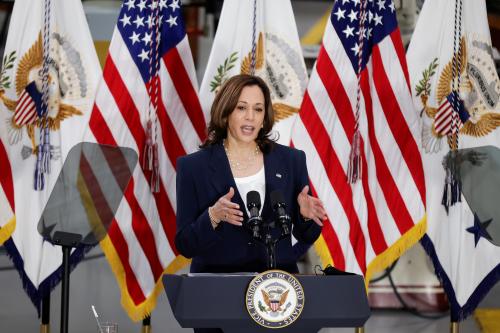If you want more content like this, subscribe to our newsletter.
This week in Class Notes:
- COVID-19 caused a “She-cession,” disproportionately hitting female labor supply following school closings and loss of jobs in entertainment and tourism.
- School inequality contributes to gaps in educational investments from low-and high-income parents, weakening intergenerational income mobility.
- Paid family leave helps employers manage worker absences—and does not affect employee performance.
- This week’s top chart shows that essential workers tested positive for COVID-19 at higher rates than non-essential workers during lockdown periods.
- In this week’s choice op-ed, our colleagues Molly Kinder and Martha Ross argue for the vital importance of investing in the nation’s “care infrastructure.”
- Check out our latest piece on the “guilty secret” of many middle-class Americans, especially women: the pandemic eased some of the time pressures on their families.
- For your calendar: Watch upcoming webinars on dispelling poverty myths, a wealth tax for creating equity, and the effect of homeownership rates on racial wealth gaps.
- Shameless self-promotion alert!!! I’ve started a podcast. It’s called Dialogues with Richard Reeves. First guest was Jonathan Haidt (and I have some more great ones lined up). Please consider subscribing. You can find the pod here, or in all the usual places, including Spotify and Apple Podcasts.
The COVID-19 recession disproportionately impacted female labor supply through school closures and the shutting down of the entertainment and tourism industries
Recent global recessions have had a disproportionate impact on male employment rates in advanced countries. But the COVID-19 recession reversed that trend. Why were women more negatively affected in the labor market this time? Titan Alon and his co-authors use micro data from U.S., Canada, and four EU countries to answer this question. They first note that while recessions usually affect male-dominated industries like construction, the COVID-19 recession hit female-heavy industries like tourism and entertainment. But this is not the whole story. The gender gap is biggest among parents of school-age children, suggesting that the closure of schools also forced many women to substitute labor supply with childcare. The gender gap in labor supply is almost entirely concentrated among workers who are unable to telecommute. This may suggest that women have the most to gain from being able to work from home, but there is a caveat. Among parents working from home with school-age children, mothers reported significantly larger productivity declines than fathers.
Unequal school opportunity may hinder intergenerational income mobility and widen differences in educational investments between low-and high-income parents
Children from poorer families typically attend worse schools. What does this mean for intergenerational income mobility? Andreu Arenas and Jean Hindriks design a theoretical model of intergenerational investment in education to answer this question. They show that unequal school opportunity arises from two distinct phenomena: a gap in school quality, and differences in additional parental investments. In the model, parents make a decision on what share of their income they want to invest in their children’s education, which is partly based on the educational returns to that investment. The key finding is that high-income parents increase their investments in education partly because their kids attend higher-quality schools, which offer higher returns to those investments; in effect a “doubling down” on inequality. As a result, intergenerational persistence of income increases at the top of the income distribution. An implication of the model is that equalizing school quality would help to break these vicious cycles, in part by encouraging greater investments in education from low-income parents.
Paid family leave improves employers’ ability to handle worker absences and does not affect employee performance
In a recent edition of Class Notes, we summarized some of the evidence that paid family leave (PFL) policies can make workers healthier. But is paid family leave good for employers too? Ann P. Bartel and her co-authors survey a representative sample of firms with 10-99 employees in New York and Pennsylvania, before and after New York passed a Paid Family Leave Act in 2018. The Act provides eight weeks of paid leave to new parents and employees caring for sick family members at a wage replacement rate of 50%. Drawing on attendance as well as opinion surveys of both employers and employees, they use a difference-in-difference approach to compare similar firms across the two states. The PFL policy increased leave-taking, especially among firms with fewer than 50 employees, which are not covered by the current federal Family and Medical Leave Act. After the PFL legislation, employers reported being significantly more capable of handling worker absences; employer ratings of employee performance and productivity were unchanged; and half of all firms expressed support for the new policy.
Top chart: Essential workers tested positive for COVID-19 at higher rates than non-essential workers during lockdown periods
This week’s top chart shows that during lockdown, essential workers in Pennsylvania were 55% more likely to test positive for COVID-19 than the rest of the population. Two weeks after the non-essential business closure order takes effect, we see a large difference in the positive test rate between essential and non-essential workers.

Choice opinion: Investing in the care economy is essential for our economic recovery
“[T]he care economy is being recognized for what it is: invisible scaffolding that allows American workers to actually get the job done…Investments in the care economy are not only long overdue, but also essential to the economic recovery and quality job growth. Functioning and affordable care is a public good: It is the foundation for Americans to provide for their families, tend to their loved ones and perform their jobs,” write Molly Kinder and Martha Ross.
Self-promotion: The pandemic may have alleviated the time squeeze for some middle class families
If you’ve been following our work lately, you’ll know we have conducted a series of in-depth interviews with middle-class families across the country to better understand their time use, financial health, and other aspects of wellbeing. This is all part of our Voices of the Middle Class project. As the COVID-19 pandemic hit and much of daily life came to a halt, we uncovered a “guilty secret” expressed by many people—especially women—in the middle class: the devastating pandemic actually eased several of the daily pressures of pre-COVID-19 life. In pre-pandemic times, many middle-class individuals were “squeezed for time and left chasing financial security that is becoming harder and harder to obtain,” often by working several jobs and simultaneously taking care of children. The lockdowns alleviated the time squeeze for some middle-class families because kids no longer had to be dropped off or picked up from school and work became remote. However, for other families, the pandemic brought about job loss and other economic hardships that threaten their middle class status. To support a more prosperous middle class and ensure a strong recovery, policymakers must provide middle-class workers a living wage and create a more robust safety net.
For your calendar: dispelling poverty myths, a wealth tax for creating equity, and the effect of homeownership rates on racial wealth gaps
Dispelling poverty myths and expanding income support
Wednesday, April 21, 2021 2:00 PM – 3:00 PM EDT
Washington Center for Equitable Growth
Fair Share: How wealth tax and progressive taxation can create equity
Tuesday, April 20, 2021 2:00 PM – 3:00 PM EDT
Roosevelt Institute
Monday, April 26, 2021 3:00 PM – 4:30 PM EDT
Urban Institute
Shameless self-promotion: New podcast
My favorite description of a dialogue is to “think together in relationship”, and that’s the unofficial motto of my new podcast. (Note that this is personal effort, not a Brookings product, so I’m grateful for permission to share it here). In the first episode I chat with Jonathan Haidt about how to make free speech better. You can find the pod here, or in all the usual places, including Spotify and Apple Podcasts.









Commentary
Class Notes: COVID-19 and women’s labor, the care economy, and more
April 22, 2021